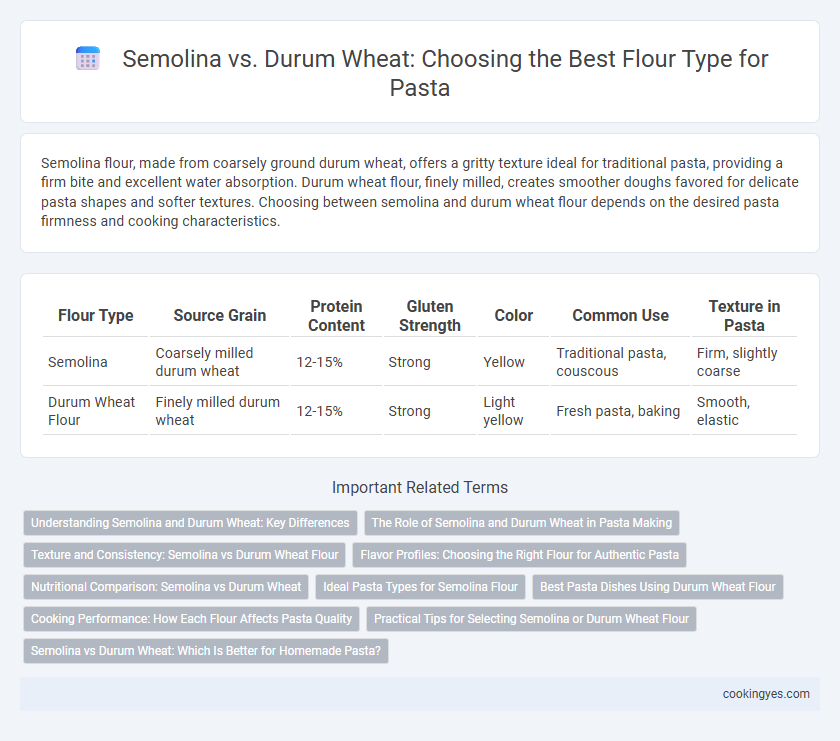Semolina flour, made from coarsely ground durum wheat, offers a gritty texture ideal for traditional pasta, providing a firm bite and excellent water absorption. Durum wheat flour, finely milled, creates smoother doughs favored for delicate pasta shapes and softer textures. Choosing between semolina and durum wheat flour depends on the desired pasta firmness and cooking characteristics.
Table of Comparison
| Flour Type | Source Grain | Protein Content | Gluten Strength | Color | Common Use | Texture in Pasta |
|---|---|---|---|---|---|---|
| Semolina | Coarsely milled durum wheat | 12-15% | Strong | Yellow | Traditional pasta, couscous | Firm, slightly coarse |
| Durum Wheat Flour | Finely milled durum wheat | 12-15% | Strong | Light yellow | Fresh pasta, baking | Smooth, elastic |
Understanding Semolina and Durum Wheat: Key Differences
Semolina is a coarse, purified wheat middling made from durum wheat, which is a hard variety of wheat known for its high protein and gluten content, making it ideal for pasta production. Durum wheat flour is finer than semolina and more suitable for baked goods and certain pasta types requiring a delicate texture. The key difference lies in texture and processing, with semolina providing a gritty texture essential for traditional pasta, while durum wheat flour offers a softer consistency.
The Role of Semolina and Durum Wheat in Pasta Making
Semolina, derived from durum wheat, is the preferred flour type in pasta making due to its high protein content and coarse texture, which contribute to a firm and elastic dough. Durum wheat's gluten strength allows pasta to hold shape and resist overcooking, resulting in al dente texture prized in culinary applications. The unique properties of semolina flour ensure superior water absorption and optimal dough consistency, making it essential for traditional and industrial pasta production.
Texture and Consistency: Semolina vs Durum Wheat Flour
Semolina flour, made from coarsely ground durum wheat, provides pasta with a firm texture and a slightly granular consistency, ideal for holding sauces well. Durum wheat flour, when finely milled, results in smoother doughs that produce tender pasta with a consistent bite. The choice between semolina and finely ground durum wheat flour directly impacts the pasta's mouthfeel and cooking resilience.
Flavor Profiles: Choosing the Right Flour for Authentic Pasta
Semolina flour, made from coarsely ground durum wheat, offers a distinct nutty and slightly sweet flavor that enhances the authentic taste of traditional Italian pasta. Durum wheat flour, being finer and lighter, produces a smoother dough with a milder flavor, allowing sauces to shine without overpowering the palate. Selecting semolina flour is ideal for robust, textured pasta like penne or rigatoni, while durum wheat flour suits delicate shapes such as fettuccine or angel hair, balancing flavor and texture perfectly.
Nutritional Comparison: Semolina vs Durum Wheat
Semolina, derived from durum wheat, is a coarse flour rich in protein, gluten, and iron, making it ideal for pasta production due to its firm texture and nutritional density. Durum wheat flour, while also high in protein and gluten, offers a finer grind and slightly higher carbohydrate content but lower fiber compared to semolina. Nutritionally, semolina provides more dietary fiber and essential minerals, contributing to better digestive health and sustained energy release.
Ideal Pasta Types for Semolina Flour
Semolina flour, derived from hard durum wheat, offers a coarse texture and high protein content ideal for pasta that requires firmness and bite. This flour is best suited for traditional Italian pasta types such as penne, rigatoni, and spaghetti, which benefit from semolina's ability to hold shape during cooking. Its granular consistency also enhances the pasta's sauce absorption, making it perfect for dishes with rich, hearty sauces.
Best Pasta Dishes Using Durum Wheat Flour
Durum wheat flour, derived from hard wheat with high protein and gluten content, is preferred for producing firm and elastic pasta that holds shape well during cooking. Semolina, a coarse grind of durum wheat, enhances pasta texture and color, making it ideal for classic Italian dishes like spaghetti carbonara and penne arrabbiata. Best pasta dishes using durum wheat flour include traditional recipes such as lasagna, fettuccine Alfredo, and rigatoni alla vodka, where the durability and bite of durum wheat pasta elevate the overall culinary experience.
Cooking Performance: How Each Flour Affects Pasta Quality
Semolina flour, made from coarse durum wheat, offers superior cooking performance by providing pasta with a firm texture and excellent water absorption, preventing mushiness during boiling. Durum wheat flour, when finely milled, results in smoother pasta with a softer bite but may lack the al dente texture prized in traditional pasta dishes. The higher protein and gluten content in semolina contribute to better pasta elasticity and shape retention, crucial for high-quality pasta production.
Practical Tips for Selecting Semolina or Durum Wheat Flour
Semolina flour, made from coarsely ground durum wheat, is ideal for pasta due to its high protein and gluten content, providing firm texture and excellent elasticity. When selecting flour, choose fine semolina for smooth pasta like fettuccine and coarse semolina for robust shapes such as rigatoni or gnocchi. Durum wheat flour, often finer than semolina, suits fresh pasta and offers a delicate bite, making it practical for handmade noodles and softer dough applications.
Semolina vs Durum Wheat: Which Is Better for Homemade Pasta?
Semolina flour, made from coarsely ground durum wheat, offers a gritty texture and high protein content ideal for firm, al dente homemade pasta. Durum wheat flour, being finer and less coarse, produces softer pasta with a smoother consistency but may lack the tensile strength needed for intricate shapes. For authentic, resilient pasta that retains shape during cooking, semolina remains the preferred choice due to its superior gluten-forming properties and optimal grind size.
Semolina vs durum wheat for flour type Infographic

 cookingyes.com
cookingyes.com